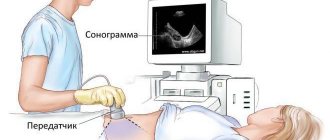Types of oligomenorrhea
Oligomenorrhea is divided into primary and secondary forms, each of them is characterized by certain causes and time of development. Deviations of this nature also include opsomenorea and hypomenorrhea.
Primary oligomenorrhea
Typically, primary oligomenorrhea can appear during the first menstrual cycle (menarche), indicating the readiness of a woman’s body to perform reproductive functions. But pregnancy at such an early age is unlikely, since puberty continues.
It is important to ensure that the onset of the first menstruation occurs on time. If menarche does not occur for a long time, you should consult a gynecologist. Timely intervention in the development of the reproductive and reproductive system will make it possible to eliminate problems associated with its functioning. If oligomenorrhea develops, it will be more difficult to bring everything back to normal.
Secondary oligomenorrhea
If we consider secondary oligomenorrhea, this process occurs when the menstrual cycle is established. The condition of this form is observed less frequently in female representatives. Such deviations occur in 3% of girls and women.
Typically, oligomenorrhea is acquired and develops against the background of inflammation in the organs of the reproductive system, hormonal imbalances, physical exhaustion and excessive stress on the nervous system. In addition, secondary oligomenorrhea can occur after an abortion.
Causes of oligomenorrhea
Oligomenorrhea can be primary or secondary. This depends on the age of the patient and whether she had a normal menstrual cycle before the onset of the pathology. Primary oligomenorrhea occurs in teenage girls. In the first years after menarche (the arrival of the first menstruation), the formation of the menstrual cycle occurs, and bleeding may be irregular and rare.
In addition, if oligomenorrhea is primary, it may be caused by hypoplasia (infantilism) of the uterus. Hypothalamic dysfunction of puberty often contributes to oligomenorrhea. Finally, hereditary factors may play a role.
Secondary oligomenorrhea is undoubtedly a deviation. Before her appearance, the girl had stably regular menstruation, but some disease caused a malfunction. Most often, the development of oligomenorrhea is promoted by ovarian dysfunction. This, in turn, is due to the following reasons:
- hormonal disorder;
- physical activity;
- stress;
- exhausting diets;
- climate change;
- taking certain medications;
- the beginning of menopause;
- neoplasms in the pelvic organs.
If oligomenorrhea is secondary, the doctor will certainly ask whether the patient has had an abortion. Such interventions often cause menstrual irregularities.
Reasons for the development of oligomenorrhea
Oligomenorrhea can be caused by the following pathologies, as well as disturbances in the functioning of the uterus and reproductive system:
- polycystic ovary syndrome;
- reduced body weight;
- disruption of brain function;
- infections of a chronic as well as acute nature;
- disruption of the endocrine glands - thyroid, pancreas, etc.;
- abortions.
The onset of primary oligomenorrhea occurs at a young age. This problem is observed as during menarche. The development of the primary condition occurs in adolescents. For several years after menarche, a menstrual cycle with a certain duration is established. Until this point, bleeding may occur rarely and without regularity.
If primary oligomenorrhea is detected, the cause of its development may be uterine hypoplasia. Quite often, this condition is observed due to hypothalamic dysfunction during puberty. The cause may also be a hereditary factor.
Primary oligomenorrhea also occurs as a result of sexual infantilism, which in turn is divided into degrees:
- The first degree is a rare anomaly in which the development of the uterus is completely disrupted and it does not form properly. With such an anomaly, there is either no menstruation at all, or they are extremely rare and scanty. It is impossible to bring the functioning of the reproductive system back to normal with such an anomaly.
- The second degree is underdevelopment of the uterus. In this case, the uterus has a structure like that of a child, and not like that of an adult woman, this causes oligomenorrhea. Proper therapy can return the reproductive system to normal.
- The third degree is precisely uterine hypoplasia. The structure corresponds to age, in contrast to the size of the uterus. Hypoplasia can be caused by infections and inflammation associated with puberty. Oligomenorrhea with hypoplasia accompanies a woman until the uterus returns to normal size as a result of therapy or natural changes in hormonal levels.
Secondary oligomenorrhea develops in women with an established menstrual cycle. If your periods were initially regular, but later began to occur with irregularities, it means that a certain disease has developed, which has provoked negative changes in the body. In many cases, secondary oligomenorrhea is a sign of impaired ovarian function. This dysfunction, in turn, occurs for the following reasons:
- stress exposure;
- changes in climatic conditions;
- adherence to exhausting diets;
- changes in hormonal levels;
- the beginning of menopause;
- formation of neoplasms in the pelvic area;
- use of certain medications;
- physical overload.
When identifying the causes of the development of secondary disorders, doctors take into account information regarding abortion. This is important because menstrual irregularities are often associated with such interventions.
Types and causes of oligomenorrhea
Taking into account the period and causes of hypomenstrual syndrome, primary and secondary oligomenorrhea are distinguished.
Primary oligomenorrhea occurs during the first menstruation (menarche), when the menstrual cycle is just beginning to form in teenage girls. The following factors can cause primary oligomenorrhea in a teenager:
- pathologies of development of the reproductive organs (infantilism, genital anomalies, etc.);
- ovarian dysfunction resulting from malfunction of the pituitary gland and hypothalamus;
- low body weight. The genital organs can function fully only if there is a sufficient amount of fatty tissue. The lack of fat leads to disturbances in the reproductive system and disruption of the menstrual cycle.
Secondary oligomenorrhea develops in women with an individually formed menstrual cycle. The following factors can provoke the occurrence of this type of hypomenstrual syndrome:
- chronic infectious, inflammatory pathologies of the genital organs;
- ovarian dysfunction arising from polycystic disease;
- tumor neoplasms of the pituitary gland;
- hormonal imbalance;
- injuries of the appendages, uterus;
- hypovitaminosis (deficiency of vitamins and nutrients in the body);
- sudden weight loss (dystrophy) or excessive weight gain (obesity);
- complications of previous gynecological procedures (therapeutic endometrial curettage, abortion, etc.).
The cause of short and rare menstruation at any age can be frequent stress and psycho-emotional stress, physical fatigue, the negative impact of occupational factors, taking hormonal medications and oral contraceptives.
In some cases, oligomenorrhea is considered a physiological condition, occurring against the background of certain processes. Short-term and scanty menstruation is considered the norm in women of premenopausal age (after 40 years) and teenage girls (in the absence of pathologies contributing to the development of primary oligomenorrhea). In adolescence, manifestations of hypomenstrual syndrome can last more than a year - this is exactly how long it takes to stabilize the cycle. Also, the appearance of oligomenorrhea is typical for women during lactation.
Signs and symptoms
The main symptom of oligomenorrhea is an increase in the intervals between menstruation. In adolescents, this condition may not present any additional symptoms, but in adult women, some symptoms are observed, the main one being hirsutism, accompanied by excess hair on the face and body.
Acne
In such cases, hair growth is observed in the places where it usually grows in men. Hair is present not only on the inner thighs, but also on those parts of the body where it usually does not grow in women - on the stomach, chest. The development of oligomenorrhea is usually caused by changes in the production of sex hormones. Among other signs of hirsutism, which was provoked by oligomenorrhea, there are the following changes:
- the menstrual cycle is disrupted;
- acne;
- extra pounds of weight;
- difficulties associated with conception;
- decreased libido;
- change in physique.
Changes in physique that oligomenorrhea causes forces female representatives to begin treatment as quickly as possible.
A normal mental state is the basis for the proper functioning of the reproductive system. Less than 29% of women experience oligomenorrhea in the absence of disorders in the nervous system. Patients do not deny that having reached the understanding that oligomenorrhea has developed, their quality of life changes, which is manifested by the following factors:
- deterioration of health;
- disturbance of peace of mind;
- lack of proper rest;
- changes in sexual activity;
- lack of material well-being.
Oligomenorrhea can have an extremely negative impact on a woman’s life, so diagnosis and treatment must be taken seriously.
Symptoms of oligomenorrhea
The main manifestation of hypomenstrual syndrome is a reduction in the duration of menstrual flow and an increase in the interval between menstruation.
If in adolescents oligomenorrhea is often asymptomatic, then in adult women short-term menstruation is accompanied by a number of unpleasant symptoms. The main one among them is hirsutism. This is excessive male-pattern hair growth. Hair begins to grow on the stomach, chest, face, inner thigh and other places where normally women should not have it.
Oligomenorrhea is also manifested by the following symptoms:
- decreased sexual desire (libido);
- problems with conception;
- male body type - pronounced bone structure and muscles (broad shoulders, narrow pelvis);
- a violation of fat metabolism, which is manifested by increased sweating, excess weight, the formation of acne and red spots on the body.
Diagnostics
Before treating oligomenorrhea, you need to make a diagnosis, figure out what form of oligomenorrhea arose, and find out what exactly led to its development. You should also realize that oligomenorrhea is an indicator of improper functioning of the body. That is why it is necessary to eliminate the cause, not the symptoms.
Oligomenorrhea is a consequence of the underlying disease, so to treat it it is necessary to find out the cause.
Diagnostics consists of several stages:
1. Taking an anamnesis. The doctor records the following information:
- age at which menstruation began;
- past illnesses;
- associated symptoms and pathological processes;
- the presence of similar disorders in close relatives;
- the duration of the period during which the formation of a regular cycle occurred after menarche (in case of secondary disorders);
- viewing data in the menstruation calendar.
2. Examination by a gynecologist:
- functional;
- instrumental;
- lab tests.
3. Examination of the pelvic organs using ultrasound. The most preferable is the transvaginal method, which is characterized by increased information content.
4. Blood test determining the levels of sex hormones:
- progesterone;
- estradiol;
- LH;
- FSH;
- prolactin.
5. Hysterosalpingoscopy aimed at checking the patency of the fallopian tubes.
You should consult a psychotherapist or psychologist. Despite the fact that this procedure is not mandatory, it is still recommended to undergo it, since it is obvious that oligomenorrhea negatively affects the moral state of girls and women.
Treatment
Depending on the disease that caused the presence of oligomenorrhea, adequate treatment is prescribed. Oligomenorrhea is a very unfavorable condition, therefore therapy should be started immediately after diagnosis and selection of suitable methods and medications. Otherwise, a woman may face infertility in the future.
If a gynecologist-endocrinologist has determined the development of oligomenorrhea, you will most likely have to be treated with medications. It should be borne in mind that therapy is based on the use of hormones and is aimed at getting rid of the manifestations of hypomenstrual syndrome by stimulating ovulation. The cycle is shortened due to active maturation of eggs.
Patients are prescribed a course of drug therapy lasting 10-12 days. As a result, menstruation begins every month, because the follicular phase is simulated artificially.
Sometimes lifestyle adjustments are enough to normalize the menstrual cycle, namely:
- adjust your diet;
- reduce the load on the body;
- limit the salt content in dishes;
- choose vitamin complexes.
Typically, such actions are effective in primary oligomenorrhea. It is more difficult to get rid of secondary disorders; some patients require surgical intervention. Most often, spot diathermocoagulation of the ovaries is performed. But such an operation is not performed on nulliparous girls, because a scar is formed, which can become an obstacle to the normal course of the birth process. An alternative option for this operation is gentle radio wave coagulation.
Upon completion of the course of drug therapy, they proceed to the use of physiotherapeutic procedures, exercise therapy, and gynecological massage. This effect on the pelvic area allows you to normalize blood circulation in this area.
Full restoration of reproductive functions requires the presence of regular periods with intervals of no more than 40 days. To record positive dynamics, the patient keeps notes, recording how the menstrual cycle goes, where she makes the following notes:
- start and end dates of menstruation;
- duration of menstruation.
To restore health, regular monitoring of the patient’s condition is required, therefore every 3 months a visit to the gynecologist is carried out.
For some causes of oligomenorrhea, an excellent treatment option is the uterus, you can read more about it here.









